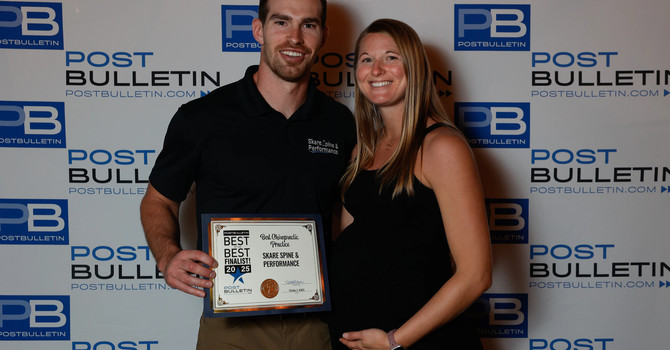
If you've been experiencing pain on the outside of your elbow that just won’t go away, especially when gripping, lifting, or even just shaking hands, you may be dealing with something called tennis elbow—and no, you don’t have to play tennis to get it.
At Skare Spine & Performance, we help active individuals recover from injuries like tennis elbow every day. In this blog, we’ll break down what tennis elbow actually is, how long it typically lasts, what treatments are available, and most importantly, how we take a comprehensive, personalized approach to help you heal and get back to doing what you love.
What is Tennis Elbow?
Tennis elbow, medically known as lateral epicondylitis, is a condition characterized by pain and tenderness on the outer part of the elbow, specifically where the tendons of the forearm muscles attach to the bony prominence (lateral epicondyle) of the elbow. Despite its name, tennis elbow is not exclusive to tennis players.
It can affect anyone who engages in repetitive arm or wrist movements, such as:
- Athletes playing sports like tennis, pickleball, or golf.
- Professionals like carpenters, painters, or plumbers who use repetitive gripping or twisting motions.
- Office workers who spend long hours typing or using a mouse.
- Hobbyists involved in activities like gardening or knitting.
The condition arises from overuse or microtears in the forearm tendons, leading to inflammation, degeneration, or irritation.
Symptoms typically include:
- Pain or burning on the outer elbow, which may radiate down the forearm.
- Weakened grip strength, making it difficult to hold objects like a racket, tool, or even a coffee mug.
- Stiffness in the elbow, especially in the morning or after prolonged activity.
Tennis elbow usually develops gradually, with symptoms worsening over time if left unaddressed. Early intervention is key to preventing chronic pain or long-term limitations.
How Long Does Tennis Elbow Last?
Like many tendon-related conditions, the healing timeline for tennis elbow can vary widely depending on several factors—including how long you've had it, what treatments you've tried, and how active you are.
- Mild cases may resolve within a few days to a few weeks with conservative care.
- Moderate to chronic cases (lasting longer than 3 months) can persist for 6 to 12 months or longer without targeted treatment.
- Untreated or poorly managed cases can linger for over a year and significantly affect quality of life.
It's important to understand that tendons don’t heal the same way muscles do. They often need more time, better load management, and strategic intervention to recover fully.
The key to a faster recovery is addressing the root cause—whether it’s repetitive strain, poor mechanics, or muscle imbalances—rather than just masking symptoms.
At Skare Spine and Performance, we focus on both symptom relief and long-term prevention to shorten recovery time and reduce recurrence.
With conservative care we can drastically help speed up the recovery timeline.
How to Treat Tennis Elbow At Home
Treating tennis elbow involves a combination of pain management, tissue healing, and restoring function.
Here are common approaches:
1. Rest and Activity Modification
- Temporarily avoid activities that aggravate symptoms, such as repetitive gripping or lifting.
- Modify techniques or equipment (e.g., using a larger racket grip or ergonomic tools) to reduce strain.
- If rest doesn’t help within a few days, it's essential to seek treatment to prevent the issue from becoming more severe.
2. Heat Therapy
- Use heat therapy to improve blood flow and relax muscles once inflammation subsides.
3. Stretching and Strengthening Exercises
- Gentle stretches for the forearm muscles can improve flexibility and reduce stiffness.
- Progressive strengthening exercises, like eccentric wrist extensions, help rebuild tendon strength.
4. Bracing or Taping
- A counterforce brace worn just below the elbow can offload stress from the tendon, reducing pain during activity.
5. Prevention
- Strengthen forearm muscles to better handle repetitive stress.
- Use proper technique during sports or work activities.
While these treatments can be effective, a one-size-fits-all approach rarely works. That’s where Skare Spine and Performance excels—by customizing care to your unique needs.
How We Treat Tennis Elbow at Skare Spine and Performance
At Skare Spine and Performance in Rochester, MN, we take a comprehensive, patient-centered approach to treating tennis elbow. Our goal is not just to relieve pain but to restore function, optimize performance, and prevent future injuries.
Here’s how we do it:
1. Thorough Assessment
- We begin with a detailed evaluation, including a physical exam, movement analysis, and discussion of your lifestyle, work, or sports demands.
- We identify contributing factors, such as repetitive movements, neck and elbow joint restrictions, and muscle imbalances.
2. Personalized Treatment Plan
- Chiropractic Care: Gentle adjustments to the elbow, wrist, or spine can improve joint mobility and reduce compensatory strain.
- Soft Tissue Therapy: Techniques like muscle release techniques or instrument-assisted soft tissue mobilization (IASTM) target scar tissue and improve tendon health.
- Dry Needling: Dry needling can reduce muscle tension and stimulate healing in the affected tendons.
- Shockwave Therapy: Radial shockwave therapy (RSWT) has been shown to stimulate tendon repair, break up calcific deposits, and reduce pain in chronic cases of tennis elbow.
- Exercise Therapy:
Progressive loading of the extensor tendons is key. This usually involves: - Isometric exercises to reduce pain
- Eccentric loading to stimulate tendon remodeling
- Grip and forearm strength training to restore function and prevent recurrence
3. Performance Optimization
- Whether it’s for golf, tennis, or life, we help improve strength and tendon resilience to help you return stronger than before, and prevent future flare ups.
4. Education and Empowerment
- We educate you on proper warm-up routines, equipment choices, and lifestyle modifications to maintain elbow health.
- We provide at-home exercises and follow-up assessments, to keep you on track.
Why Choose Skare Spine and Performance?
- Expertise: Our team combines chiropractic care, sports, and performance training for a holistic approach.
- Individualized Care: No cookie-cutter treatments—every plan is tailored to your goals and needs.
- Local Commitment: As a Rochester, MN-based chiropractic practice, we’re dedicated to helping our community thrive.
Recover from Tennis Elbow
Tennis elbow can be a painful setback, but with the right care, you can recover fully and return to the activities you love. At Skare Spine and Performance, we’re here to guide you through every step of the process, from diagnosis to performance optimization. If you’re struggling with elbow pain, don’t wait—contact us today to schedule an evaluation and start your journey to pain-free movement.

Nate Skare
Contact Me



